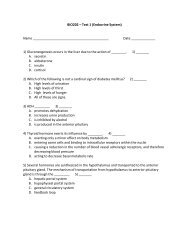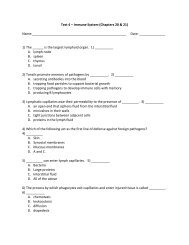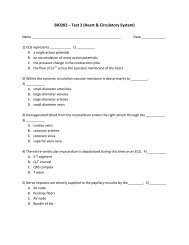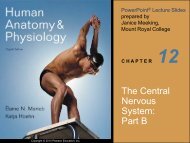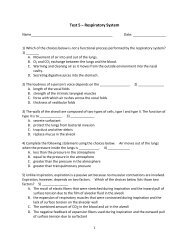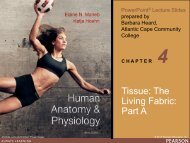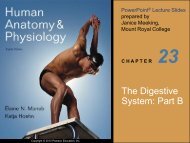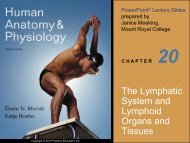Chapter 14 - Next2Eden
Chapter 14 - Next2Eden
Chapter 14 - Next2Eden
Create successful ePaper yourself
Turn your PDF publications into a flip-book with our unique Google optimized e-Paper software.
PowerPoint ® Lecture Slides<br />
prepared by<br />
Janice Meeking,<br />
Mount Royal College<br />
C H A P T E R<br />
<strong>14</strong><br />
The<br />
Autonomic<br />
Nervous<br />
System<br />
Copyright © 2010 Pearson Education, Inc.
Central nervous system (CNS)<br />
Peripheral nervous system (PNS)<br />
Sensory (afferent)<br />
division<br />
Motor (efferent) division<br />
Somatic nervous<br />
system<br />
Autonomic nervous<br />
system (ANS)<br />
Sympathetic<br />
division<br />
Parasympathetic<br />
division<br />
Copyright © 2010 Pearson Education, Inc.<br />
Figure <strong>14</strong>.1
Somatic and Autonomic Nervous Systems<br />
• The two systems differ in<br />
• Effectors<br />
• Efferent pathways (and their<br />
neurotransmitters)<br />
• Target organ responses to neurotransmitters<br />
Copyright © 2010 Pearson Education, Inc.
Autonomic Nervous System (ANS)<br />
• The ANS consists of motor neurons that:<br />
• Innervate smooth and cardiac muscle and<br />
glands<br />
• Make adjustments to ensure optimal support<br />
for body activities<br />
• Operate via subconscious control<br />
Copyright © 2010 Pearson Education, Inc.
Autonomic Nervous System (ANS)<br />
• Other names<br />
• Involuntary nervous system<br />
• General visceral motor system<br />
Copyright © 2010 Pearson Education, Inc.
Effectors<br />
• Somatic nervous system<br />
• Skeletal muscles<br />
• ANS<br />
• Cardiac muscle<br />
• Smooth muscle<br />
• Glands<br />
Copyright © 2010 Pearson Education, Inc.
Efferent Pathways<br />
• Somatic nervous system<br />
• A, thick, heavily myelinated somatic motor fiber makes<br />
up each pathway from the CNS to the muscle<br />
• ANS pathway is a two-neuron chain<br />
1. Preganglionic neuron (in CNS) has a thin, lightly<br />
myelinated preganglionic axon<br />
2. Ganglionic neuron in autonomic ganglion has an<br />
unmyelinated postganglionic axon that extends to<br />
the effector organ<br />
Copyright © 2010 Pearson Education, Inc.
Neurotransmitter Effects<br />
• Somatic nervous system<br />
• All somatic motor neurons release acetylcholine (ACh)<br />
• Effects are always stimulatory<br />
• ANS<br />
• Preganglionic fibers release ACh<br />
• Postganglionic fibers release norepinephrine or<br />
ACh at effectors<br />
• Effect is either stimulatory or inhibitory, depending on<br />
type of receptors<br />
Copyright © 2010 Pearson Education, Inc.
SOMATIC<br />
NERVOUS<br />
SYSTEM<br />
AUTONOMIC NERVOUS SYSTEM<br />
PARASYMPATHETIC SYMPATHETIC<br />
Know this chart...<br />
Neuro-<br />
Cell bodies in central<br />
transmitter Effector<br />
nervous system Peripheral nervous system at effector organs Effect<br />
Single neuron from CNS to effector organs<br />
Heavily myelinated axon<br />
ACh<br />
Skeletal muscle<br />
+<br />
Stimulatory<br />
Two-neuron chain from CNS to effector organs<br />
ACh<br />
NE<br />
Lightly myelinated<br />
preganglionic axons<br />
ACh<br />
Lightly myelinated<br />
preganglionic axon<br />
Ganglion<br />
Adrenal medulla<br />
Unmyelinated<br />
postganglionic axon<br />
Epinephrine and<br />
norepinephrine<br />
ACh<br />
Ganglion<br />
Blood vessel<br />
Unmyelinated<br />
postganglionic<br />
axon<br />
ACh<br />
Smooth muscle<br />
(e.g., in gut),<br />
glands, cardiac<br />
muscle<br />
+<br />
Stimulatory<br />
or inhibitory,<br />
depending<br />
on neurotransmitter<br />
and<br />
receptors<br />
on effector<br />
organs<br />
Acetylcholine (ACh)<br />
Norepinephrine (NE)<br />
Copyright © 2010 Pearson Education, Inc.<br />
Figure <strong>14</strong>.2
Divisions of the ANS<br />
1.Sympathetic division<br />
2.Parasympathetic division<br />
• Dual innervation<br />
• Almost all visceral organs are served by both<br />
divisions, but they cause opposite effects<br />
Copyright © 2010 Pearson Education, Inc.
Role of the Parasympathetic Division<br />
• Promotes maintenance activities and<br />
conserves body energy<br />
• Its activity is illustrated in a person who<br />
relaxes, reading, after a meal<br />
• Blood pressure, heart rate, and respiratory<br />
rates are low<br />
• Gastrointestinal tract activity is high<br />
• Pupils are constricted and lenses are<br />
accommodated for close vision<br />
Copyright © 2010 Pearson Education, Inc.
Role of the Sympathetic Division<br />
• Mobilizes the body during activity; is the<br />
“fight-or-flight” system<br />
• Promotes adjustments during exercise, or<br />
when threatened<br />
• Blood flow is shunted to skeletal muscles<br />
and heart<br />
• Bronchioles dilate<br />
• Liver releases glucose<br />
• Eye site is adjusted for long distance<br />
detection<br />
Copyright © 2010 Pearson Education, Inc.
ANS Anatomy<br />
Division<br />
Origin of<br />
Fibers<br />
Length of<br />
Fibers<br />
Location<br />
of<br />
Ganglia<br />
Sympathetic<br />
Thoracolumbar<br />
region of the<br />
spinal cord<br />
Short<br />
preganglionic<br />
and long<br />
postganglionic<br />
Close to<br />
spinal<br />
cord<br />
Parasympathetic Brain and<br />
sacral spinal<br />
cord<br />
(craniosacral)<br />
Long<br />
preganglionic<br />
and short<br />
postganglionic<br />
In<br />
visceral<br />
effector<br />
organs<br />
Copyright © 2010 Pearson Education, Inc.
Parasympathetic<br />
Sympathetic<br />
Eye<br />
Salivary<br />
glands<br />
Heart<br />
Cervical<br />
Brain<br />
stem<br />
Cranial<br />
Sympathetic<br />
ganglia<br />
Eye<br />
Skin*<br />
Salivary<br />
glands<br />
Lungs<br />
Lungs<br />
Heart<br />
Stomach<br />
Pancreas<br />
Liver and<br />
gallbladder<br />
Thoracic<br />
L 1<br />
Lumbar<br />
T 1<br />
Stomach<br />
Pancreas<br />
Liver<br />
and gallbladder<br />
Adrenal<br />
gland<br />
Figure <strong>14</strong>.3<br />
Bladder<br />
Genitals<br />
Sacral<br />
Bladder<br />
Genitals<br />
Copyright © 2010 Pearson Education, Inc.
Parasympathetic (Craniosacral) Division<br />
Outflow<br />
Cranial<br />
Outflow<br />
Cranial Nerve<br />
Ganglia<br />
(Terminal Ganglia)<br />
Oculomotor (III) Ciliary Eye<br />
Effector Organ(s)<br />
Sacral<br />
Outflow<br />
Facial (VII)<br />
Glossopharyngeal<br />
(IX)<br />
Vagus (X)<br />
S 2 -S 4<br />
Pterygopalatine<br />
Submandibular<br />
Otic<br />
Within the walls<br />
of target organs<br />
Within the walls<br />
of target organs<br />
Salivary, nasal, and<br />
lacrimal glands<br />
Parotid salivary glands<br />
Heart, lungs, and<br />
most visceral organs<br />
Large intestine,<br />
urinary bladder,<br />
ureters, and<br />
reproductive organs<br />
Copyright © 2010 Pearson Education, Inc.
CN III<br />
CN VII<br />
CN IX<br />
CN X<br />
Ciliary<br />
ganglion<br />
Pterygopalatine<br />
ganglion<br />
Submandibular<br />
ganglion<br />
Otic ganglion<br />
Eye<br />
Lacrimal<br />
gland<br />
Nasal<br />
mucosa<br />
Submandibular<br />
and sublingual<br />
glands<br />
Parotid gland<br />
Cardiac and<br />
pulmonary<br />
plexuses<br />
Heart<br />
Lung<br />
Celiac<br />
plexus<br />
Liver and<br />
gallbladder<br />
Stomach<br />
Pancreas<br />
S 2<br />
S 4<br />
Pelvic<br />
splanchnic<br />
nerves<br />
Inferior<br />
hypogastric<br />
plexus<br />
Genitalia<br />
(penis,<br />
clitoris, and vagina)<br />
Rectum<br />
Large<br />
intestine<br />
Small<br />
intestine<br />
Urinary<br />
bladder<br />
and ureters<br />
Preganglionic<br />
Postganglionic<br />
Cranial nerve<br />
Copyright © 2010 Pearson Education, Inc.<br />
Figure <strong>14</strong>.4
Sympathetic (Thoracolumbar) Division<br />
• Preganglionic neurons are in spinal cord<br />
segments T 1 – L 2<br />
• Sympathetic neurons produce the lateral<br />
horns of the spinal cord<br />
• Preganglionic fibers pass through the white<br />
rami communicantes and enter sympathetic<br />
trunk (paravertebral) ganglia<br />
Copyright © 2010 Pearson Education, Inc.
Eye<br />
Lacrimal gland<br />
T 1<br />
Pons<br />
Superior<br />
cervical<br />
ganglion<br />
Middle<br />
cervical<br />
ganglion<br />
Inferior<br />
cervical<br />
ganglion<br />
Sympathetic trunk<br />
(chain) ganglia<br />
Cardiac and<br />
pulmonary<br />
plexuses<br />
Nasal mucosa<br />
Blood vessels;<br />
skin (arrector pili<br />
muscles and<br />
sweat glands)<br />
Salivary glands<br />
Heart<br />
Lung<br />
Greater splanchnic nerve<br />
Lesser splanchnic nerve<br />
Celiac ganglion<br />
Liver and<br />
gallbladder<br />
L 2<br />
White rami<br />
communicantes<br />
Sacral<br />
splanchnic<br />
nerves<br />
Superior<br />
mesenteric<br />
ganglion<br />
Lumbar<br />
splanchnic<br />
nerves<br />
Inferior<br />
mesenteric<br />
ganglion<br />
Stomach<br />
Spleen<br />
Adrenal medulla<br />
Kidney<br />
Small<br />
intestine<br />
Large<br />
intestine<br />
Rectum<br />
Preganglionic<br />
Postganglionic<br />
Genitalia (uterus, vagina, and<br />
penis) and urinary bladder<br />
Copyright © 2010 Pearson Education, Inc. Figure <strong>14</strong>.6
Sympathetic Trunks and Pathways<br />
• There are 23 paravertebral ganglia in the<br />
sympathetic trunk (chain)<br />
• 3 cervical<br />
• 11 thoracic<br />
• 4 lumbar<br />
• 4 sacral<br />
• 1 coccygeal<br />
Copyright © 2010 Pearson Education, Inc.
Spinal cord<br />
Dorsal root<br />
Ventral root<br />
Rib<br />
Sympathetic<br />
trunk ganglion<br />
Sympathetic<br />
trunk<br />
Ventral ramus<br />
of spinal nerve<br />
Gray ramus<br />
communicans<br />
White ramus<br />
communicans<br />
Thoracic<br />
splanchnic nerves<br />
(a) Location of the sympathetic trunk<br />
Copyright © 2010 Pearson Education, Inc. Figure <strong>14</strong>.5a
Sympathetic Trunks and Pathways<br />
• Upon entering a sympathetic trunk<br />
ganglion a preganglionic fiber may do one<br />
of the following:<br />
1. Synapse with a ganglionic neuron within the<br />
same ganglion<br />
2. Ascend or descend the sympathetic trunk to<br />
synapse in another trunk ganglion<br />
3. Pass through the trunk ganglion and emerge<br />
without synapsing<br />
Copyright © 2010 Pearson Education, Inc.
Skin (arrector<br />
pili muscles<br />
and sweat<br />
glands)<br />
Lateral horn (visceral<br />
motor zone)<br />
Dorsal root<br />
Dorsal root ganglion<br />
Dorsal ramus of<br />
spinal nerve<br />
Ventral ramus of<br />
spinal nerve<br />
Gray ramus<br />
communicans<br />
White ramus<br />
communicans<br />
To effector<br />
1<br />
Ventral root<br />
Sympathetic<br />
trunk ganglion<br />
Sympathetic trunk<br />
Synapse at the same level<br />
Blood vessels<br />
(b) Three pathways of sympathetic innervation<br />
Copyright © 2010 Pearson Education, Inc. Figure <strong>14</strong>.5b (1 of 3)
Skin (arrector<br />
pili muscles<br />
and sweat<br />
glands)<br />
To effector<br />
Blood vessels<br />
2<br />
Synapse at a higher or lower level<br />
(b) Three pathways of sympathetic innervation<br />
Copyright © 2010 Pearson Education, Inc. Figure <strong>14</strong>.5b (2 of 3)
Splanchnic nerve<br />
Collateral ganglion<br />
(such as the celiac)<br />
Target organ<br />
in abdomen<br />
(e.g., intestine)<br />
3 Synapse in a distant collateral ganglion<br />
anterior to the vertebral column<br />
(b) Three pathways of sympathetic innervation<br />
Copyright © 2010 Pearson Education, Inc. Figure <strong>14</strong>.5b (3 of 3)
Sympathetic Pathways with Synapses in<br />
Trunk Ganglia...pathway choice #1 and #2<br />
• This is a common event<br />
• Postganglionic axons enter the ventral<br />
rami via the gray rami communicantes<br />
• These fibers innervate<br />
• Sweat glands<br />
• Arrector pili muscles<br />
• Vascular smooth muscle (particularly<br />
important for blood pressure!)<br />
Copyright © 2010 Pearson Education, Inc.
Spinal cord<br />
Dorsal root<br />
Ventral root<br />
Rib<br />
Sympathetic<br />
trunk ganglion<br />
Sympathetic<br />
trunk<br />
Ventral ramus<br />
of spinal nerve<br />
Gray ramus<br />
communicans<br />
White ramus<br />
communicans<br />
Thoracic<br />
splanchnic nerves<br />
(a) Location of the sympathetic trunk<br />
Copyright © 2010 Pearson Education, Inc. Figure <strong>14</strong>.5a
Sympathetic Pathways to the Head...option<br />
#2<br />
• Fibers emerge from T 1 – T 4 and synapse in<br />
the superior cervical ganglion<br />
• These fibers<br />
• Innervate skin and blood vessels of the<br />
head<br />
• Stimulate dilator muscles of the iris (more<br />
light)<br />
• Inhibit nasal and salivary glands (dry<br />
mouth)<br />
Copyright © 2010 Pearson Education, Inc.
Eye<br />
Lacrimal gland<br />
T 1<br />
Pons<br />
Superior<br />
cervical<br />
ganglion<br />
Middle<br />
cervical<br />
ganglion<br />
Inferior<br />
cervical<br />
ganglion<br />
Sympathetic trunk<br />
(chain) ganglia<br />
Cardiac and<br />
pulmonary<br />
plexuses<br />
Nasal mucosa<br />
Blood vessels;<br />
skin (arrector pili<br />
muscles and<br />
sweat glands)<br />
Salivary glands<br />
Heart<br />
Lung<br />
Greater splanchnic nerve<br />
Lesser splanchnic nerve<br />
Celiac ganglion<br />
Liver and<br />
gallbladder<br />
L 2<br />
White rami<br />
communicantes<br />
Sacral<br />
splanchnic<br />
nerves<br />
Superior<br />
mesenteric<br />
ganglion<br />
Lumbar<br />
splanchnic<br />
nerves<br />
Inferior<br />
mesenteric<br />
ganglion<br />
Stomach<br />
Spleen<br />
Adrenal medulla<br />
Kidney<br />
Small<br />
intestine<br />
Large<br />
intestine<br />
Rectum<br />
Preganglionic<br />
Postganglionic<br />
Genitalia (uterus, vagina, and<br />
penis) and urinary bladder<br />
Copyright © 2010 Pearson Education, Inc. Figure <strong>14</strong>.6
Sympathetic Pathways to the Thorax<br />
• Preganglionic fibers emerge from T 1 – T 6 and<br />
synapse in the cervical trunk ganglia<br />
• Postganglionic fibers emerge from the middle<br />
and inferior cervical ganglia and enter nerves<br />
C 4 – C 8<br />
• These fibers innervate:<br />
• Heart via the cardiac plexus<br />
• Thyroid gland and the skin<br />
• Lungs and esophagus<br />
Copyright © 2010 Pearson Education, Inc.
Eye<br />
Lacrimal gland<br />
T 1<br />
Pons<br />
Superior<br />
cervical<br />
ganglion<br />
Middle<br />
cervical<br />
ganglion<br />
Inferior<br />
cervical<br />
ganglion<br />
Sympathetic trunk<br />
(chain) ganglia<br />
Cardiac and<br />
pulmonary<br />
plexuses<br />
Nasal mucosa<br />
Blood vessels;<br />
skin (arrector pili<br />
muscles and<br />
sweat glands)<br />
Salivary glands<br />
Heart<br />
Lung<br />
Greater splanchnic nerve<br />
Lesser splanchnic nerve<br />
Celiac ganglion<br />
Liver and<br />
gallbladder<br />
L 2<br />
White rami<br />
communicantes<br />
Sacral<br />
splanchnic<br />
nerves<br />
Superior<br />
mesenteric<br />
ganglion<br />
Lumbar<br />
splanchnic<br />
nerves<br />
Inferior<br />
mesenteric<br />
ganglion<br />
Stomach<br />
Spleen<br />
Adrenal medulla<br />
Kidney<br />
Small<br />
intestine<br />
Large<br />
intestine<br />
Rectum<br />
Preganglionic<br />
Postganglionic<br />
Genitalia (uterus, vagina, and<br />
penis) and urinary bladder<br />
Copyright © 2010 Pearson Education, Inc. Figure <strong>14</strong>.6
Sympathetic Pathways to the<br />
Abdomen...pathway option #3<br />
• Preganglionic fibers from T 5 – L 2 travel<br />
through the thoracic splanchnic nerves<br />
• Synapses occur in the celiac and superior<br />
mesenteric ganglia<br />
• Postganglionic fibers serve the stomach,<br />
intestines, liver, spleen, and kidneys<br />
Copyright © 2010 Pearson Education, Inc.
Eye<br />
Lacrimal gland<br />
T 1<br />
Pons<br />
Superior<br />
cervical<br />
ganglion<br />
Middle<br />
cervical<br />
ganglion<br />
Inferior<br />
cervical<br />
ganglion<br />
Sympathetic trunk<br />
(chain) ganglia<br />
Cardiac and<br />
pulmonary<br />
plexuses<br />
Nasal mucosa<br />
Blood vessels;<br />
skin (arrector pili<br />
muscles and<br />
sweat glands)<br />
Salivary glands<br />
Heart<br />
Lung<br />
Greater splanchnic nerve<br />
Lesser splanchnic nerve<br />
Celiac ganglion<br />
Liver and<br />
gallbladder<br />
L 2<br />
White rami<br />
communicantes<br />
Sacral<br />
splanchnic<br />
nerves<br />
Superior<br />
mesenteric<br />
ganglion<br />
Lumbar<br />
splanchnic<br />
nerves<br />
Inferior<br />
mesenteric<br />
ganglion<br />
Stomach<br />
Spleen<br />
Adrenal medulla<br />
Kidney<br />
Small<br />
intestine<br />
Large<br />
intestine<br />
Rectum<br />
Preganglionic<br />
Postganglionic<br />
Genitalia (uterus, vagina, and<br />
penis) and urinary bladder<br />
Copyright © 2010 Pearson Education, Inc. Figure <strong>14</strong>.6
Sympathetic Pathways to the Pelvis...<br />
lumbar segment<br />
• Preganglionic fibers from T 10 – L 2 travel via<br />
the lumbar splanchnic nerves<br />
• Synapses occur in the inferior mesenteric and<br />
hypogastric ganglia...pathway #3<br />
• Postganglionic fibers serve the distal half<br />
of the large intestine<br />
Copyright © 2010 Pearson Education, Inc.
Eye<br />
Lacrimal gland<br />
T 1<br />
Pons<br />
Superior<br />
cervical<br />
ganglion<br />
Middle<br />
cervical<br />
ganglion<br />
Inferior<br />
cervical<br />
ganglion<br />
Sympathetic trunk<br />
(chain) ganglia<br />
Cardiac and<br />
pulmonary<br />
plexuses<br />
Nasal mucosa<br />
Blood vessels;<br />
skin (arrector pili<br />
muscles and<br />
sweat glands)<br />
Salivary glands<br />
Heart<br />
Lung<br />
Greater splanchnic nerve<br />
Lesser splanchnic nerve<br />
Celiac ganglion<br />
Liver and<br />
gallbladder<br />
L 2<br />
White rami<br />
communicantes<br />
Sacral<br />
splanchnic<br />
nerves<br />
Superior<br />
mesenteric<br />
ganglion<br />
Lumbar<br />
splanchnic<br />
nerves<br />
Inferior<br />
mesenteric<br />
ganglion<br />
Stomach<br />
Spleen<br />
Adrenal medulla<br />
Kidney<br />
Small<br />
intestine<br />
Large<br />
intestine<br />
Rectum<br />
Preganglionic<br />
Postganglionic<br />
Genitalia (uterus, vagina, and<br />
penis) and urinary bladder<br />
Copyright © 2010 Pearson Education, Inc. Figure <strong>14</strong>.6
Sympathetic Pathways to the Pelvis...sacral<br />
innervation<br />
• Preganglionic fibers from T 10 – L 2 travel via<br />
the sacral splanchnic nerves<br />
• Synapses occur in the sympathetic<br />
trunk...pathways #1 and #2<br />
• Postganglionic fibers serve the the urinary<br />
bladder, and the reproductive organs<br />
Copyright © 2010 Pearson Education, Inc.
Eye<br />
Lacrimal gland<br />
T 1<br />
Pons<br />
Superior<br />
cervical<br />
ganglion<br />
Middle<br />
cervical<br />
ganglion<br />
Inferior<br />
cervical<br />
ganglion<br />
Sympathetic trunk<br />
(chain) ganglia<br />
Cardiac and<br />
pulmonary<br />
plexuses<br />
Nasal mucosa<br />
Blood vessels;<br />
skin (arrector pili<br />
muscles and<br />
sweat glands)<br />
Salivary glands<br />
Heart<br />
Lung<br />
Greater splanchnic nerve<br />
Lesser splanchnic nerve<br />
Celiac ganglion<br />
Liver and<br />
gallbladder<br />
L 2<br />
White rami<br />
communicantes<br />
Sacral<br />
splanchnic<br />
nerves<br />
Superior<br />
mesenteric<br />
ganglion<br />
Lumbar<br />
splanchnic<br />
nerves<br />
Inferior<br />
mesenteric<br />
ganglion<br />
Stomach<br />
Spleen<br />
Adrenal medulla<br />
Kidney<br />
Small<br />
intestine<br />
Large<br />
intestine<br />
Rectum<br />
Preganglionic<br />
Postganglionic<br />
Genitalia (uterus, vagina, and<br />
penis) and urinary bladder<br />
Copyright © 2010 Pearson Education, Inc. Figure <strong>14</strong>.6
Sympathetic Pathways with Synapses in the<br />
Adrenal Medulla<br />
• Some preganglionic fibers from T 10 – L 2<br />
travel pass directly to the adrenal medulla<br />
without synapsing<br />
• Upon stimulation, medullary cells secrete<br />
norepinephrine and epinephrine into the<br />
blood<br />
Copyright © 2010 Pearson Education, Inc.
Visceral Reflexes<br />
• Visceral reflex arcs have the same<br />
components as somatic reflexes<br />
• Main difference: visceral reflex arc has two<br />
neurons in the motor pathway...no<br />
interneruon<br />
• Visceral pain afferents travel along the<br />
same pathways as somatic pain fibers,<br />
contributing to the phenomenon of<br />
referred pain<br />
Copyright © 2010 Pearson Education, Inc.
Stimulus<br />
1 Sensory receptor<br />
in viscera<br />
2 Visceral sensory<br />
neuron<br />
3 Integration center<br />
• May be preganglionic<br />
neuron (as shown)<br />
• May be a dorsal horn<br />
interneuron<br />
• May be within walls<br />
of gastrointestinal tract<br />
4 Efferent pathway<br />
(two-neuron chain)<br />
• Preganglionic neuron<br />
• Ganglionic neuron<br />
5 Visceral effector<br />
Dorsal root ganglion<br />
Spinal cord<br />
Autonomic ganglion<br />
Response<br />
Copyright © 2010 Pearson Education, Inc. Figure <strong>14</strong>.7
Neurotransmitters<br />
• Cholinergic fibers release the neurotransmitter<br />
ACh<br />
• All ANS preganglionic axons<br />
• All parasympathetic postganglionic axons<br />
• Adrenergic fibers release the neurotransmitter<br />
NE<br />
• Most sympathetic postganglionic axons<br />
• Exceptions: sympathetic postganglionic fibers<br />
secrete ACh at sweat glands and some blood<br />
vessels in skeletal muscles<br />
Copyright © 2010 Pearson Education, Inc.
AUTONOMIC NERVOUS SYSTEM<br />
PARASYMPATHETIC SYMPATHETIC<br />
Two-neuron chain from CNS to effector organs<br />
ACh<br />
NE<br />
Unmyelinated<br />
Ganglion<br />
postganglionic axon<br />
Lightly myelinated<br />
Epinephrine and<br />
preganglionic axons norepinephrine<br />
ACh<br />
Lightly myelinated<br />
preganglionic axon<br />
Adrenal medulla<br />
ACh<br />
Ganglion<br />
Blood vessel<br />
Unmyelinated<br />
postganglionic<br />
axon<br />
ACh<br />
Smooth muscle<br />
(e.g., in gut),<br />
glands, cardiac<br />
muscle<br />
+<br />
Stimulatory<br />
or inhibitory,<br />
depending<br />
on neurotransmitter<br />
and<br />
receptors<br />
on effector<br />
organs<br />
Acetylcholine (ACh)<br />
Norepinephrine (NE)<br />
Copyright © 2010 Pearson Education, Inc. Figure <strong>14</strong>.2
Interactions of the Autonomic Divisions<br />
• Most visceral organs have dual innervation<br />
• Dynamic antagonism allows for precise<br />
control of visceral activity<br />
• Sympathetic division increases heart and<br />
respiratory rates, and inhibits digestion<br />
and elimination<br />
• Parasympathetic division decreases heart<br />
and respiratory rates, and allows for<br />
digestion and the discarding of wastes<br />
Copyright © 2010 Pearson Education, Inc.
Sympathetic Tone<br />
• Sympathetic division controls blood<br />
pressure, even at rest<br />
• Sympathetic tone (vasomotor tone)<br />
• Keeps the blood vessels in a continual<br />
state of partial constriction<br />
Copyright © 2010 Pearson Education, Inc.
Sympathetic Tone<br />
• Sympathetic fibers fire more rapidly to<br />
constrict blood vessels and cause blood<br />
pressure to rise<br />
• Sympathetic fibers fire less rapidly to<br />
prompt vessels to dilate to decrease blood<br />
pressure<br />
• Adrenergic alpha-blocker drugs interfere<br />
with vasomotor fibers and are used to treat<br />
hypertension<br />
Copyright © 2010 Pearson Education, Inc.
Parasympathetic Tone<br />
• Parasympathetic division normally dominates the<br />
heart and smooth muscle of digestive and<br />
urinary tract organs<br />
• Slows the heart<br />
• Dictates normal activity levels of the digestive and<br />
urinary tracts<br />
• The sympathetic division can override these<br />
effects during times of stress<br />
• Drugs that block parasympathetic responses<br />
increase heart rate and cause fecal and urinary<br />
retention<br />
Copyright © 2010 Pearson Education, Inc.
Unique Roles of the Sympathetic Division<br />
• The adrenal medulla, sweat glands, arrector pili<br />
muscles, kidneys, and most blood vessels<br />
receive only sympathetic fibers<br />
• The sympathetic division controls<br />
• Thermoregulatory responses to heat<br />
• Release of renin from the kidneys<br />
• Metabolic effects<br />
• Increases metabolic rates of cells<br />
• Raises blood glucose levels<br />
• Mobilizes fats for use as fuels<br />
Copyright © 2010 Pearson Education, Inc.
Localized Versus Diffuse Effects<br />
• Parasympathetic division: short-lived,<br />
highly localized control over effectors<br />
• Sympathetic division: long-lasting,<br />
bodywide effects<br />
Copyright © 2010 Pearson Education, Inc.
Effects of Sympathetic Activation<br />
• Sympathetic activation is long lasting<br />
because NE<br />
• Is inactivated more slowly than ACh<br />
• NE and epinephrine are released into the<br />
blood and remain there until destroyed by<br />
the liver<br />
Copyright © 2010 Pearson Education, Inc.
Control of ANS Functioning...think<br />
hypothalamus<br />
• Hypothalamus—main integrative center of<br />
ANS activity<br />
• Subconscious cerebral input via limbic lobe<br />
connections influences hypothalamic<br />
function<br />
• Other controls come from the cerebral cortex,<br />
the reticular formation, and the spinal cord<br />
Copyright © 2010 Pearson Education, Inc.
Hypothalamic Control<br />
• Control may be direct or indirect (through the<br />
reticular system)<br />
• Centers of the hypothalamus control<br />
• Heart activity and blood pressure<br />
• Body temperature, water balance, and endocrine<br />
activity<br />
• Emotional stages (rage, pleasure) and biological<br />
drives (hunger, thirst, sex)<br />
• Reactions to fear and the “fight-or-flight” system<br />
Copyright © 2010 Pearson Education, Inc.
Communication at<br />
subconscious level<br />
Cerebral cortex<br />
(frontal lobe)<br />
Limbic system<br />
(emotional input)<br />
Hypothalamus<br />
Overall integration<br />
of ANS, the boss<br />
Brain stem<br />
(reticular formation, etc.)<br />
Regulation of pupil size,<br />
respiration, heart, blood<br />
pressure, swallowing, etc.<br />
Spinal cord<br />
Urination, defecation,<br />
erection, and ejaculation<br />
reflexes<br />
Copyright © 2010 Pearson Education, Inc. Figure <strong>14</strong>.9



